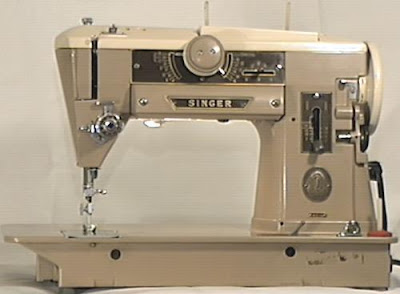While we own a cheap Chinese sewing machine, I wanted something with more "guts".
I researched older sewing machines made entirely of metal, with enough punch to see multiple layers of Sunbrella. I kept coming across referenced to the "greatest sewing machine ever made", the Singer 401.
This machine retailed in 1959 for the equivalent of $2600 USD, so it was something to be coveted and then treasured.
Well, 55 years later our society has become disposable and these machines can be found for a song. I found one at an online auction for $55 NZD ($45USD).
It is in mint condition with all the factory bits.
I can't wait to start sewing.
Update 10/1/14
As with everything I own, the machine was torn down into it's primary components, cleaned and polished, including a kerosene soak and a complete lubrication, and a complete polish and wax of the enamel surface. I am now ready to make covers for everything! :)
 |
| My 1959/1960 Singer 401G sewing machine, renowned for being one of the best sewing machines ever built. I am using an enormous jeans/canvas needle. |
Necessity (and poverty) is the mother of invention. Why spend $20 for a plastic thread cone holder with a coat-hangar protruding from it? I have some dowel kicking around, and a bit of epoxy. You must have something like this when you use the giant cones of UV-treated thread.
UPDATE 23/1/14
Well, as wonderful a machine this is (and it is both wonderful to use and look at), it is simply not up to the challenge of stitching multiple layers (greater than 3) of Sunbrella. With webbing and more Sunbrella in the future, I'm afraid I must look for another machine, something semi or fully commercial.
I will certainly keep the Singer, as it will very handy for more conventional activities.
One of the models I'm now investigating is the Sailrite Ultrafeed, a unit that I lusted after years ago, and one that by all reports has been tremendously improved in the new version. An email inquiry to Sailrite was responded to within minutes by the President of the company...wow!
UPDATE 22/2/14
The projects start to roll out while I continue to shop for a heavy duty machine.
Well, after an exhaustive (and global) 3-month search for a sewing machine that was capable of sewing heavy-weight marine materials, I stumbled across a machine at a local auction. It is a Durkopp Adler 67, an older (30 years?) machine, but it is the Mercedes Benz of sewing machines. They sell used anywhere from $1500-$3000, but I bought this one for $70....it's not much to look at, but with some restoration it will be perfect for the job.
I pick it up this weekend, but here is a "sistership" photo:
 |
| This is a 167-73AE, mine is an older 067 model, identical but for the size of the bobbin. |
Rumour has it these machines will sew through 1/4" plywood.
UPDATE 15/4/14:
My machine is now in the garage, and of course...it is a project in itself. It is a true barn find, with a lot of cleaning ahead of me. Consider these to be the "before" photos:
 |
| An Adler 67AE-72E36, built perhaps 50 years ago. It's cosmetically showing it's age, but it's built of the best German steel, and is un-rivalled in the world of industrial sewing machines. |
 |
| Hey! Another varnishing job....great... |
 |
| Golly...this is going to need a good cleaning. |
Update 19/4/14
I've got the machine clean, just polishing and lubricating. It's remarkable the difference turning it by hand from filthy, to clean and oiled. This is a BEAST of a machine, I estimate 35kg.
Update 20/4/14 - I have the machine back together, here is what I achieved in 1 week:
1. Refinished the table top with 5 coats of varnish ( the stains and scars I left for character)
2. Refinished the table frame with 3 coats of white epoxy enamel.
3. Cleaned and lubricated the machine, including the bobbin winder.
4. Removed the Quick clutch motor and installed a Powermax AH27 servo motor, which is 1/3 the size and 1/10 the weight. I can see at 60 stitches/min with full control (incredible).
UPDATE 11/4/14
SEWING...FINALLY
Update 16/5/14
Fender covers!
UPDATE 13/8/14
It has been a long time coming, but the dodger has been re-stitched and the clear panels replaced. This has been on "the list" for 2 years.













